Drag Force and Heat Transfer Characteristics of Ellipsoidal Particles near the Wall
Abstract
:1. Introduction
2. Research Method
2.1. Large Eddy Simulation
2.2. Control Equation
2.3. Dimensionless Parameter
2.4. The Governing Equation and Simulation Parameters
2.5. Setting of Boundary Conditions
2.6. Meshing and Grid Independence Verification
2.7. Validation
3. Results and Discussion
3.1. Influence of Reynolds Number on Drag Coefficient
3.2. The Influence of Particle Orientation on the Drag Coefficient
3.3. The Effect of Aspect Ratio on the Drag Coefficient
3.4. The Effect of Reynolds Number on Heat Transfer Performance
3.5. The Effect of Particle Orientation on Heat Transfer Performance
3.6. Effect of Aspect Ratio on the Heat Transfer Performance
4. Conclusions
- Reynolds Number Influence: At Re = 500, turbulence mitigates wall interference, leading to a 14.4% increase in the Nusselt number (Nu) compared to lower Reynolds number cases. Simultaneously, wall-induced drag diminishes significantly, stabilizing the fluid flow.
- Particle Orientation Effect: When the particle’s long axis is parallel to the wall ( = 90), Nu decreases by 20%, indicating substantial flow obstruction. Conversely, orientations with a larger windward area result in a 35% increase in drag force compared to = 0°.
- Aspect Ratio Impact: Particles with higher aspect ratios (Ar = 0.8) demonstrate a 25% greater heat transfer efficiency and an 18% reduction in drag coefficient compared to those with Ar = 0.1, owing to enhanced aerodynamic properties and smoother flow interactions.
- Particle–Wall Distance Effect: As the particle–wall distance (H) increases from 0.25 to 0.5, wall-induced drag decreases by over 30%, reducing flow restrictions and enhancing heat transfer uniformity.
Author Contributions
Funding
Data Availability Statement
Conflicts of Interest
References
- Gray, J.M.N.T.; Gajjar, P.; Kokelaar, P. Particle-Size Segregation in Dense Granular Avalanches. C. R. Phys. 2015, 16, 73–85. [Google Scholar] [CrossRef]
- Bao, X.; Wu, H.; Xiong, H.; Chen, X. Particle Shape Effects on Submarine Landslides via CFD-DEM. Ocean Eng. 2023, 284, 115140. [Google Scholar] [CrossRef]
- Leonardi, A.; Wittel, F.K.; Mendoza, M.; Vetter, R.; Herrmann, H.J. Particle–Fluid–Structure Interaction for Debris Flow Impact on Flexible Barriers. Comput.-Aided Civ. Infrastruct. Eng. 2016, 31, 323–333. [Google Scholar] [CrossRef]
- Chen, Q.; Xiong, T.; Zhang, X.; Jiang, P. Study of the Hydraulic Transport of Non-Spherical Particles in a Pipeline Based on the CFD-DEM. Eng. Appl. Comput. Fluid Mech. 2020, 14, 53–69. [Google Scholar] [CrossRef]
- Tatemoto, Y.; Mibu, T.; Yokoi, Y.; Hagimoto, A. Effect of Freezing Pretreatment on the Drying Characteristics and Volume Change of Carrots Immersed in a Fluidized Bed of Inert Particles under Reduced Pressure. J. Food Eng. 2016, 173, 150–157. [Google Scholar] [CrossRef]
- Zhong, W.; Yu, A.; Zhou, G.; Xie, J.; Zhang, H. CFD Simulation of Dense Particulate Reaction System: Approaches, Recent Advances and Applications. Chem. Eng. Sci. 2016, 140, 16–43. [Google Scholar] [CrossRef]
- Kishore, N.; Gu, S. Momentum and Heat Transfer Phenomena of Spheroid Particles at Moderate Reynolds and Prandtl Numbers. Int. J. Heat Mass Transf. 2011, 54, 2595–2601. [Google Scholar] [CrossRef]
- Motlagh, A.H.A.; Hashemabadi, S.H. 3D CFD Simulation and Experimental Validation of Particle-to-Fluid Heat Transfer in a Randomly Packed Bed of Cylindrical Particles. Int. Commun. Heat Mass Transf. 2008, 35, 1183–1189. [Google Scholar] [CrossRef]
- Adamczyk, W.P.; Klimanek, A.; Białecki, R.A.; Węcel, G.; Kozołub, P.; Czakiert, T. Comparison of the Standard Euler–Euler and Hybrid Euler–Lagrange Approaches for Modeling Particle Transport in a Pilot-Scale Circulating Fluidized Bed. Particuology 2014, 15, 129–137. [Google Scholar] [CrossRef]
- Zhang, Y.; Lu, X.-B.; Zhang, X.-H. An Optimized Eulerian–Lagrangian Method for Two-Phase Flow with Coarse Particles: Implementation in Open-Source Field Operation and Manipulation, Verification, and Validation. Phys. Fluids 2021, 33, 113307. [Google Scholar] [CrossRef]
- Lyu, H.; Lucas, D.; Rzehak, R.; Schlegel, F. A Particle-Center-Averaged Euler-Euler Model for Monodisperse Bubbly Flows. Chem. Eng. Sci. 2022, 260, 117943. [Google Scholar] [CrossRef]
- Zhao, Y.; Lu, B.; Zhong, Y. Euler–Euler Modeling of a Gas–Solid Bubbling Fluidized Bed with Kinetic Theory of Rough Particles. Chem. Eng. Sci. 2013, 104, 767–779. [Google Scholar] [CrossRef]
- Frank, T. Parallele Algorithmen für Die Numerische Simulation Dreidimensionaler, Disperser Mehrphasenströmungen und Deren Anwendung in der Verfahrenstechnik; Shaker Verlag GmbH: Düren, Germany, 2002. [Google Scholar]
- Ray, M.; Chowdhury, F.; Sowinski, A.; Mehrani, P.; Passalacqua, A. An Euler-Euler Model for Mono-Dispersed Gas-Particle Flows Incorporating Electrostatic Charging Due to Particle-Wall and Particle-Particle Collisions. Chem. Eng. Sci. 2019, 197, 327–344. [Google Scholar] [CrossRef]
- Wittig, K.; Nikrityuk, P.; Richter, A. Drag Coefficient and Nusselt Number for Porous Particles under Laminar Flow Conditions. Int. J. Heat Mass Transf. 2017, 112, 1005–1016. [Google Scholar] [CrossRef]
- Muyshondt, R.; Nguyen, T.; Hassan, Y.A.; Anand, N.K. Experimental Measurements of the Wake of a Sphere at Subcritical Reynolds Numbers. J. Fluids Eng. 2021, 143, 061301. [Google Scholar] [CrossRef]
- Deen, N.G.; Kriebitzsch, S.H.L.; Van Der Hoef, M.A.; Kuipers, J.A.M. Direct Numerical Simulation of Flow and Heat Transfer in Dense Fluid–Particle Systems. Chem. Eng. Sci. 2012, 81, 329–344. [Google Scholar] [CrossRef]
- Brian, P.L.T.; Hales, H.B. Effects of Transpiration and Changing Diameter on Heat and Mass Transfer to Spheres. AIChE J. 1969, 15, 419–425. [Google Scholar] [CrossRef]
- Augier, F.; Idoux, F.; Delenne, J.Y. Numerical Simulations of Transfer and Transport Properties inside Packed Beds of Spherical Particles. Chem. Eng. Sci. 2010, 65, 1055–1064. [Google Scholar] [CrossRef]
- Clift, R.; Grace, J.R.; Weber, M.E. Bubbles, Drops, and Particles; Courier Corporation: North Chelmsford, MA, USA, 2005. [Google Scholar]
- Latham, J.-P.; Munjiza, A. The Modelling of Particle Systems with Real Shapes. Philos. Trans. R. Soc. Lond. Ser. A Math. Phys. Eng. Sci. 2004, 362, 1953–1972. [Google Scholar] [CrossRef]
- Barker, D.A.; Arceo-Gomez, G. Pollen Transport Networks Reveal Highly Diverse and Temporally Stable Plant–Pollinator Interactions in an Appalachian Floral Community. AoB Plants 2021, 13, plab062. [Google Scholar] [CrossRef]
- Chu, Y.-M.; Khan, U.; Shafiq, A.; Zaib, A. Numerical Simulations of Time-Dependent Micro-Rotation Blood Flow Induced by a Curved Moving Surface Through Conduction of Gold Particles with Non-Uniform Heat Sink/Source. Arab. J. Sci. Eng. 2021, 46, 2413–2427. [Google Scholar] [CrossRef]
- Luo, S.; Feng, Y.; Song, J.; Xu, D.; Xia, K. Powder Fuel Transport Process and Mixing Characteristics in Cavity-Based Supersonic Combustor with Different Injection Schemes. Aerosp. Sci. Technol. 2022, 128, 107798. [Google Scholar] [CrossRef]
- Zhong, W.; Yu, A.; Liu, X.; Tong, Z.; Zhang, H. DEM/CFD-DEM Modelling of Non-Spherical Particulate Systems: Theoretical Developments and Applications. Powder Technol. 2016, 302, 108–152. [Google Scholar] [CrossRef]
- Roos, F.W.; Willmarth, W.W. Some Experimental Results on Sphere and Disk Drag. AIAA J. 1971, 9, 285–291. [Google Scholar] [CrossRef]
- Yang, W.J.; Zhou, Z.Y.; Yu, A.B. Particle Scale Studies of Heat Transfer in a Moving Bed. Powder Technol. 2015, 281, 99–111. [Google Scholar] [CrossRef]
- Yasuji, T.; Takeuchi, H.; Kawashima, Y. Particle Design of Poorly Water-Soluble Drug Substances Using Supercritical Fluid Technologies. Adv. Drug Deliv. Rev. 2008, 60, 388–398. [Google Scholar] [CrossRef] [PubMed]
- Chen, Y.-L.; Qin, J.-C.; Sun, H.-P.; Shang, T.; Zhang, X.-G.; Hu, Y. Global Optimization for Cross-Domain Aircraft Based on Kriging Model and Particle Swarm Optimization Algorithm. Sci. Iran. 2021, 28, 209–222. [Google Scholar] [CrossRef]
- Hottovy, J.D.; Sylvester, N.D. Drag Coefficients for Irregularly Shaped Particles. Ind. Eng. Chem. Proc. Des. Dev. 1979, 18, 433–436. [Google Scholar] [CrossRef]
- Renganathan, K.; Turton, R.; Clark, N.N. Accelerating Motion of Geometric and Spherical Particles in a Fluid. Powder Technol. 1989, 58, 279–284. [Google Scholar] [CrossRef]
- Kasper, G.; Niida, T.; Yang, M. Measurements of Viscous Drag on Cylinders and Chains of Spheres with Aspect Ratios between 2 and 50. J. Aerosol Sci. 1985, 16, 535–556. [Google Scholar] [CrossRef]
- Wang, J.; Qi, H.; Zhu, J. Experimental Study of Settling and Drag on Cuboids with Square Base. Particuology 2011, 9, 298–305. [Google Scholar] [CrossRef]
- Zhou, C.; Su, J.; Chen, H.; Shi, Z. Terminal Velocity and Drag Coefficient Models for Disc-Shaped Particles Based on the Imaging Experiment. Powder Technol. 2022, 398, 117062. [Google Scholar] [CrossRef]
- Cebeci, T.; Meier, H. Turbulent Boundary Layers on a Prolate Spheroid. In Proceedings of the 19th AIAA, Fluid Dynamics, Plasma Dynamics, and Lasers Conference, Honolulu, HI, USA, 8–10 June 1987; American Institute of Aeronautics and Astronautics: Honolulu, HI, USA, 1987. [Google Scholar] [CrossRef]
- Ganser, G.H. A Rational Approach to Drag Prediction of Spherical and Nonspherical Particles. Powder Technol. 1993, 77, 143–152. [Google Scholar] [CrossRef]
- Haider, A.; Levenspiel, O. Drag Coefficient and Terminal Velocity of Spherical and Nonspherical Particles. Powder Technol. 1989, 58, 63–70. [Google Scholar] [CrossRef]
- Hölzer, A.; Sommerfeld, M. New simple correlation formula for the drag coefficient of non-spherical particles. Powder Technol. 2008, 184, 361–365. [Google Scholar] [CrossRef]
- Richter, A.; Nikrityuk, P.A. Drag Forces and Heat Transfer Coefficients for Spherical, Cuboidal and Ellipsoidal Particles in Cross Flow at Sub-Critical Reynolds Numbers. Int. J. Heat Mass Transf. 2012, 55, 1343–1354. [Google Scholar] [CrossRef]
- Rong, L.W.; Zhou, Z.Y.; Yu, A.B. Lattice–Boltzmann Simulation of Fluid Flow through Packed Beds of Uniform Ellipsoids. Powder Technol. 2015, 285, 146–156. [Google Scholar] [CrossRef]
- Sanjeevi, S.K.P.; Kuipers, J.A.M.; Padding, J.T. Drag, Lift and Torque Correlations for Non-Spherical Particles from Stokes Limit to High Reynolds Numbers. Int. J. Multiph. Flow 2018, 106, 325–337. [Google Scholar] [CrossRef]
- Ke, C.; Shu, S.; Zhang, H.; Yuan, H.; Yang, D. On the Drag Coefficient and Averaged Nusselt Number of an Ellipsoidal Particle in a Fluid. Powder Technol. 2018, 325, 134–144. [Google Scholar] [CrossRef]
- Mirhashemi, F.S.; Hashemabadi, S.H.; Noroozi, S. CFD Simulation and Experimental Validation for Wall Effects on Heat Transfer of Finite Cylindrical Catalyst. Int. Commun. Heat Mass Transf. 2011, 38, 1148–1155. [Google Scholar] [CrossRef]
- El Hasadi, Y.M.F.; Padding, J.T. Solving fluid flow problems using semi-supervised symbolic regression on sparse data. AIP Adv. 2019, 9, 115218. [Google Scholar] [CrossRef]
- Toghraie, D.; Afrand, M.; Zadeh, A.D.; Akbari, H.A. Numerical Investigation on the Flow and Heat Transfer of a Multi-Lobe Particle and Equivalent Spherical Particles in a Packed Bed with Considering the Wall Effects. Int. J. Mech. Sci. 2018, 138–139, 350–367. [Google Scholar] [CrossRef]
- Zare, M.; Hashemabadi, S.H. Particle-Fluid Heat Transfer Close to the Bed Wall: CFD Simulation and Experimental Study of Particle Shape Influence on the Formation of Hot Zones. Int. J. Therm. Sci. 2020, 150, 106223. [Google Scholar] [CrossRef]
- Pirozzoli, S.; Modesti, D.; Orlandi, P.; Grasso, F. Turbulence and Secondary Motions in Square Duct Flow. J. Fluid Mech. 2018, 840, 631–655. [Google Scholar] [CrossRef]
- Yao, J.; Zhao, Y.; Fairweather, M. Numerical Simulation of Turbulent Flow through a Straight Square Duct. Appl. Therm. Eng. 2015, 91, 800–811. [Google Scholar] [CrossRef]
- Zhang, H.; Trias, F.X.; Gorobets, A.; Tan, Y.; Oliva, A. Direct Numerical Simulation of a Fully Developed Turbulent Square Duct Flow up to Re τ = 1200. Int. J. Heat Fluid Flow 2015, 54, 258–267. [Google Scholar] [CrossRef]
- Clark, R.A.; Ferziger, J.H.; Reynolds, W.C. Evaluation of Subgrid-Scale Models Using an Accurately Simulated Turbulent Flow. J. Fluid Mech. 1979, 91, 1–16. [Google Scholar] [CrossRef]
- Ferziger, J.; Leslie, D. Large Eddy Simulation—A Predictive Approach to Turbulent Flow Computation. In Proceedings of the 4th Computational Fluid Dynamics Conference, Williamsburg, VA, USA, 23–25 July 1979; American Institute of Aeronautics and Astronautics: Williamsburg, VA, USA, 1979. [Google Scholar] [CrossRef]
- Moin, P.; Kim, J. Numerical Investigation of Turbulent Channel Flow. J. Fluid Mech. 1982, 118, 341–377. [Google Scholar] [CrossRef]
- Adams, J.F.W.; Fairweather, M.; Yao, J. Modelling and Simulation of Particle Re-Suspension in a Turbulent Square Duct Flow. Comput. Chem. Eng. 2011, 35, 893–900. [Google Scholar] [CrossRef]
- Su, M.; Chen, Q.; Chiang, C.-M. Comparison of Different Subgrid-Scale Models of Large Eddy Simulation for Indoor Airflow Modeling. J. Fluids Eng. 2001, 123, 628–639. [Google Scholar] [CrossRef]

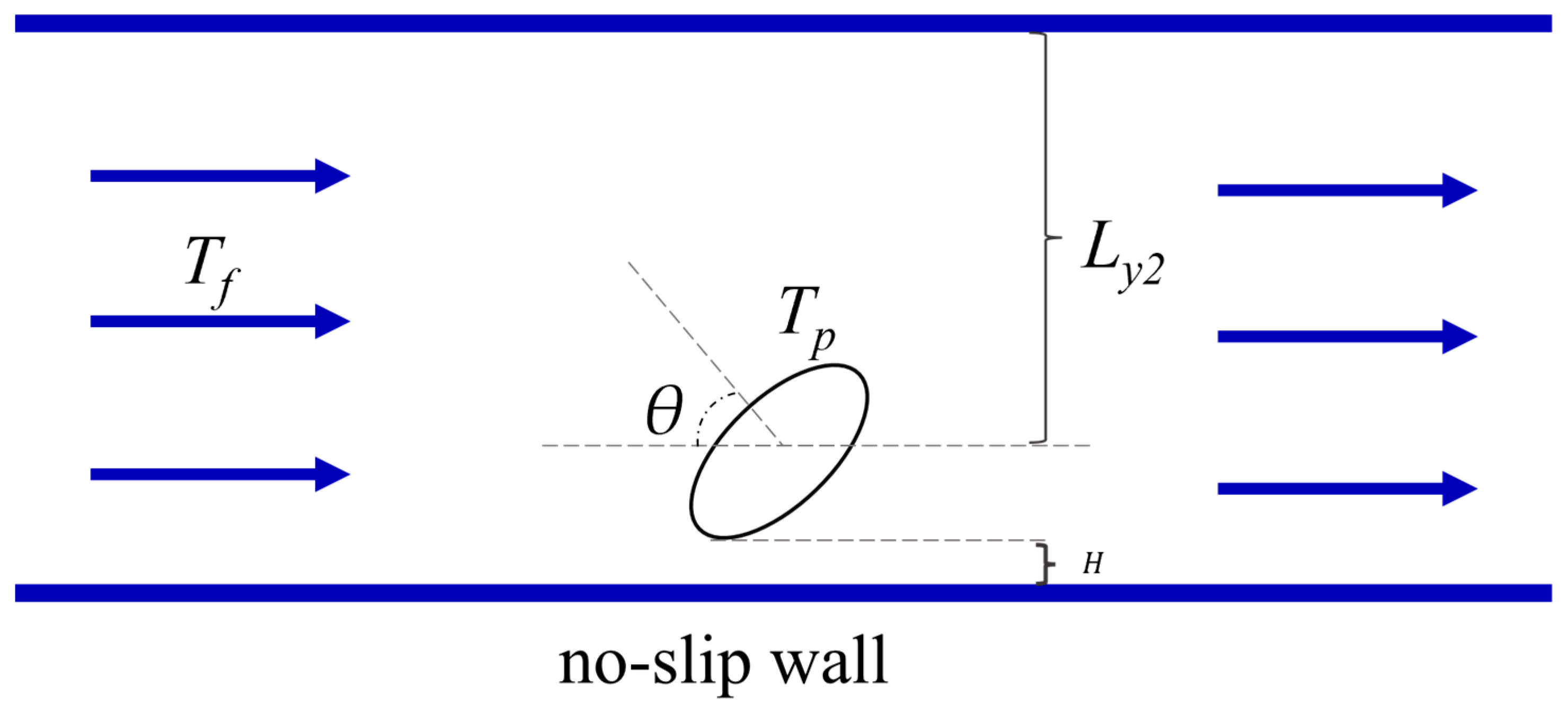
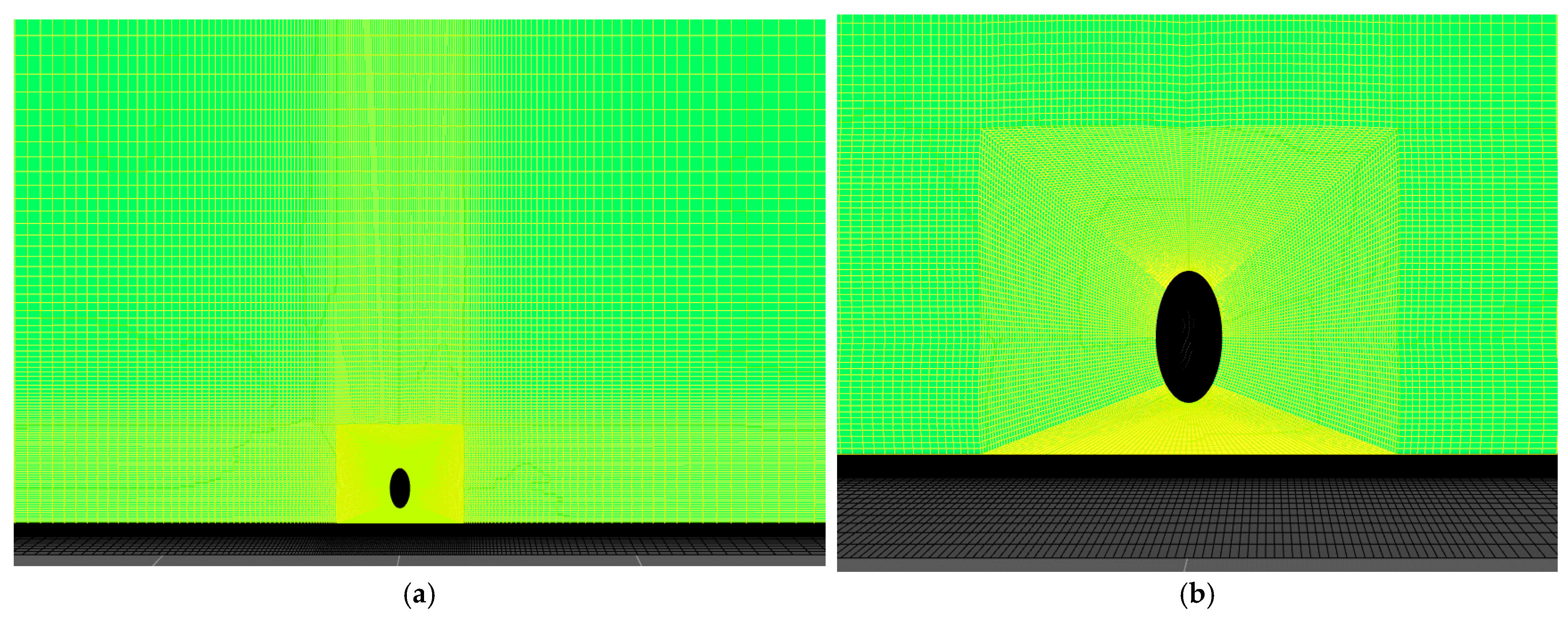
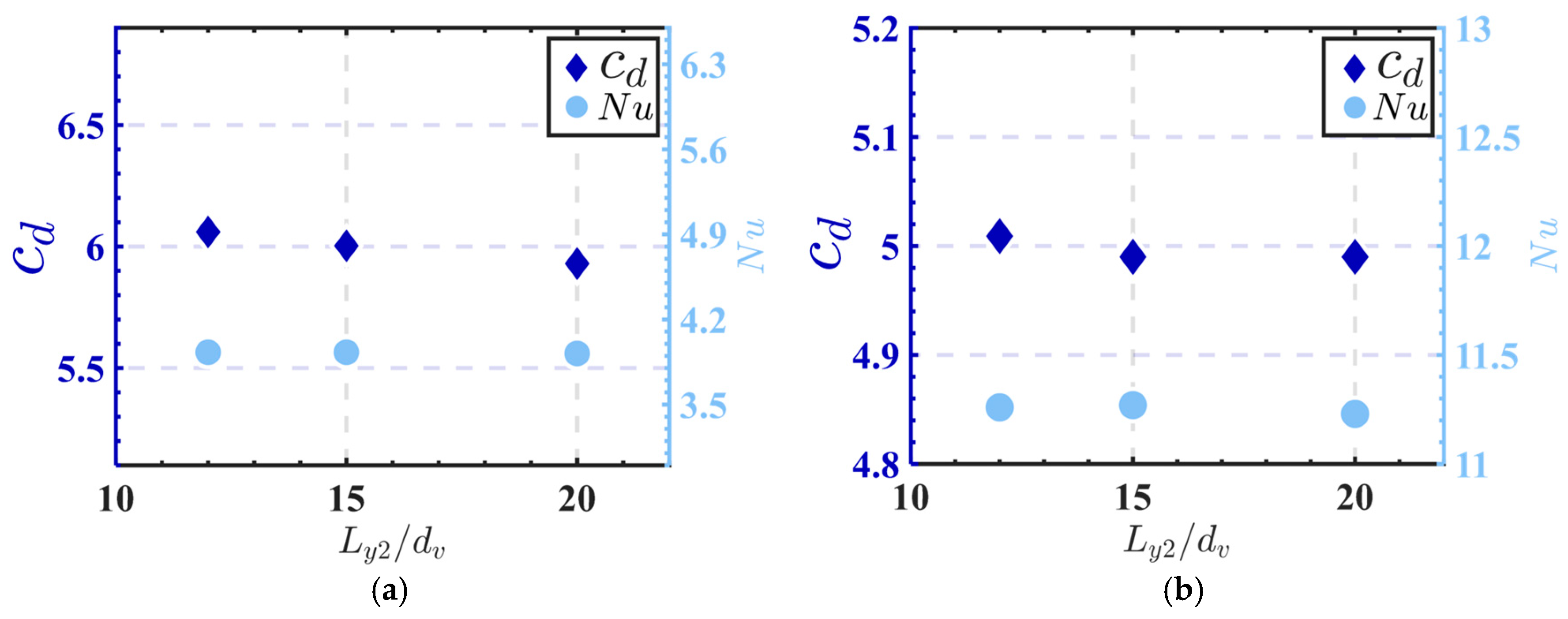
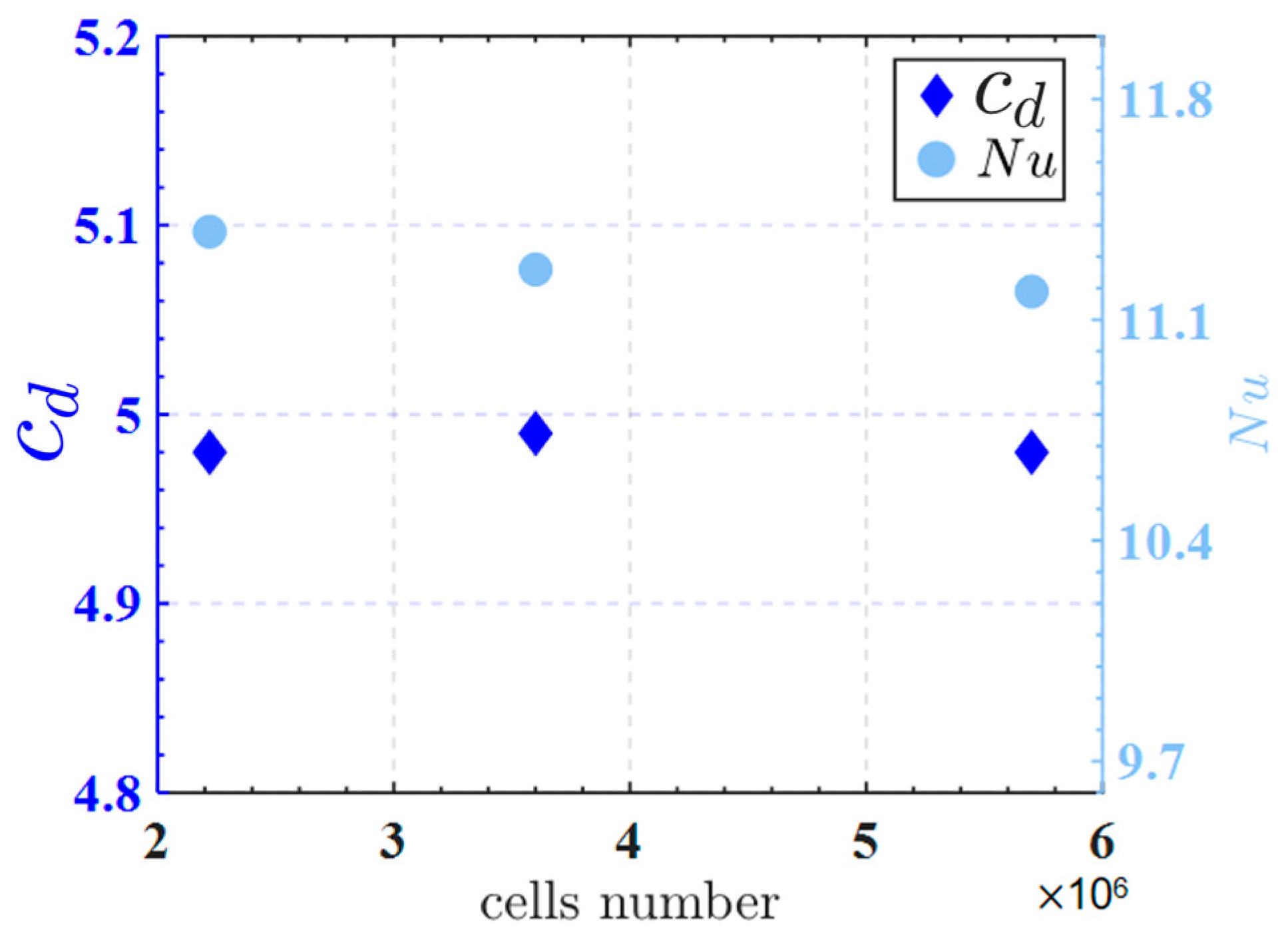
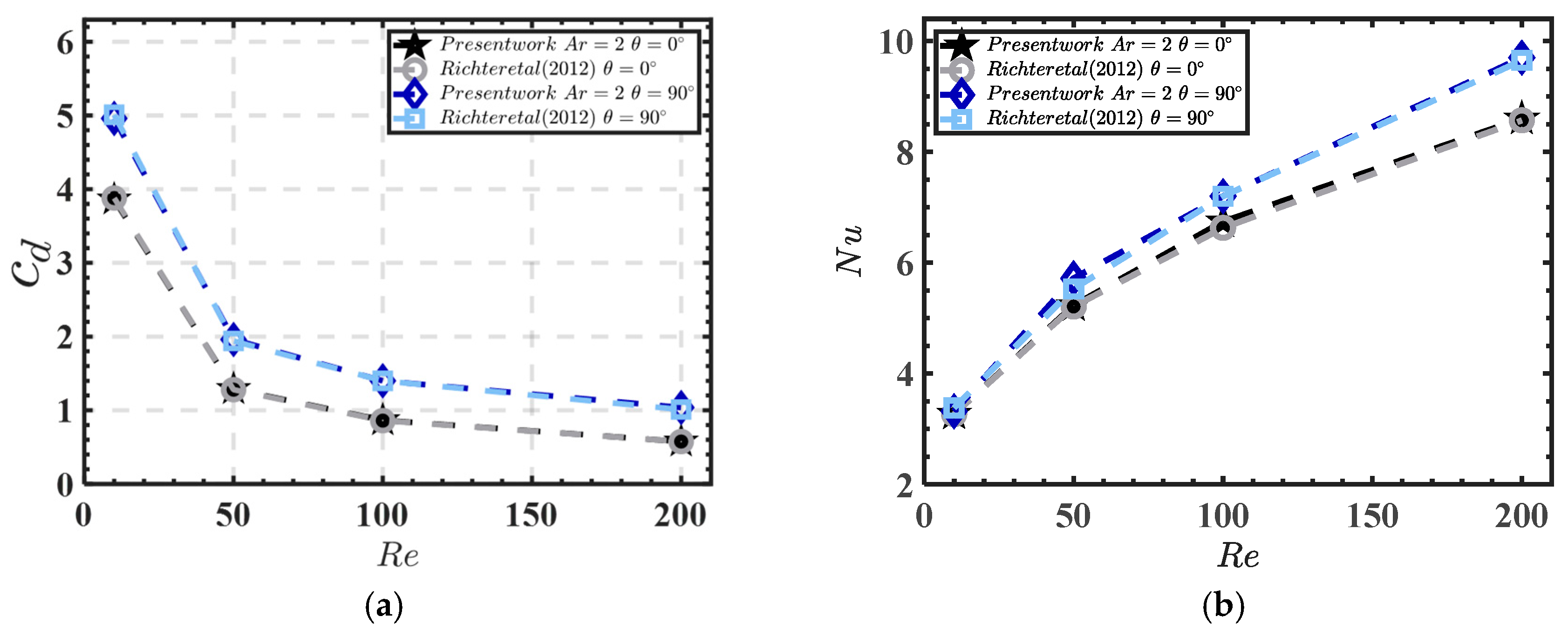
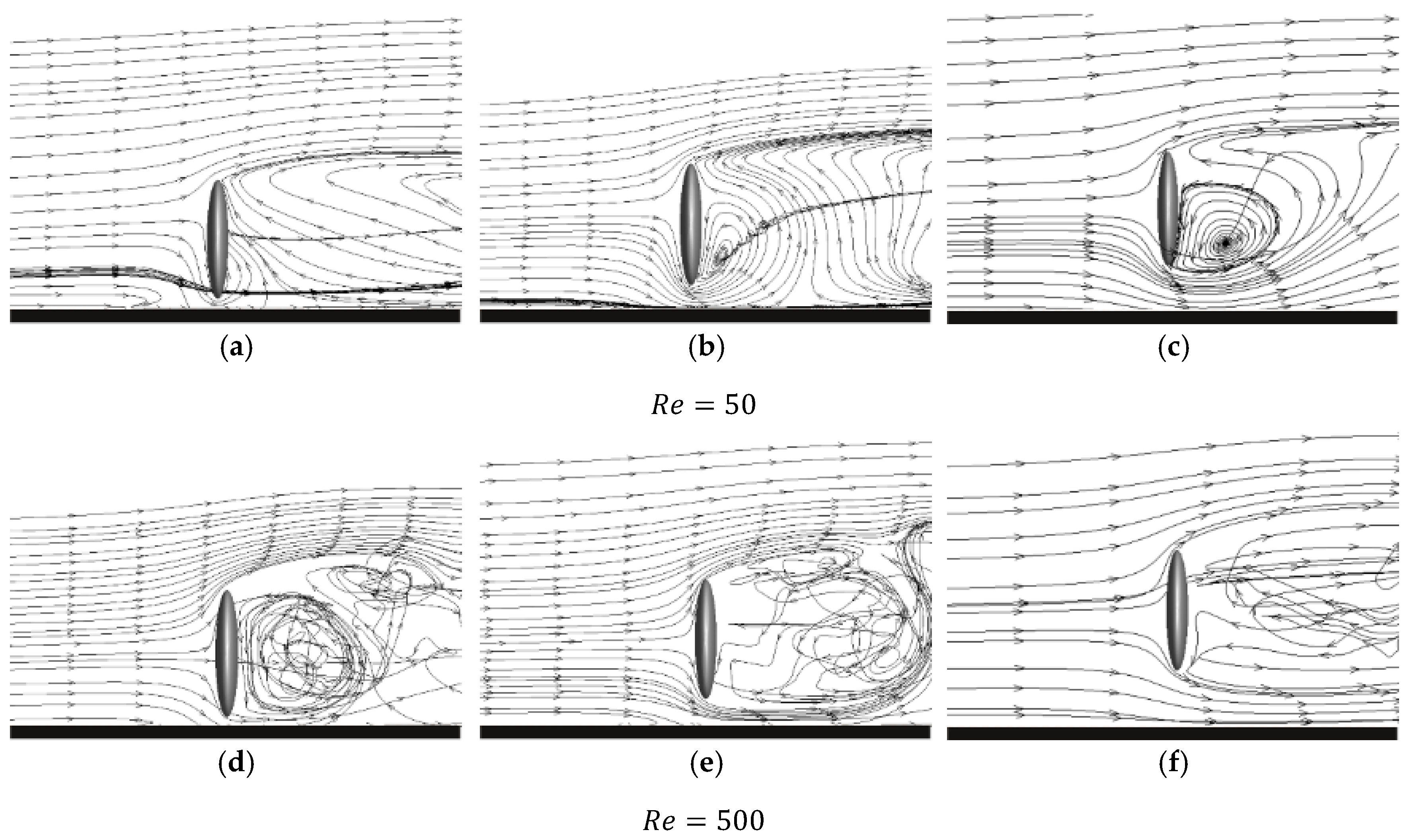
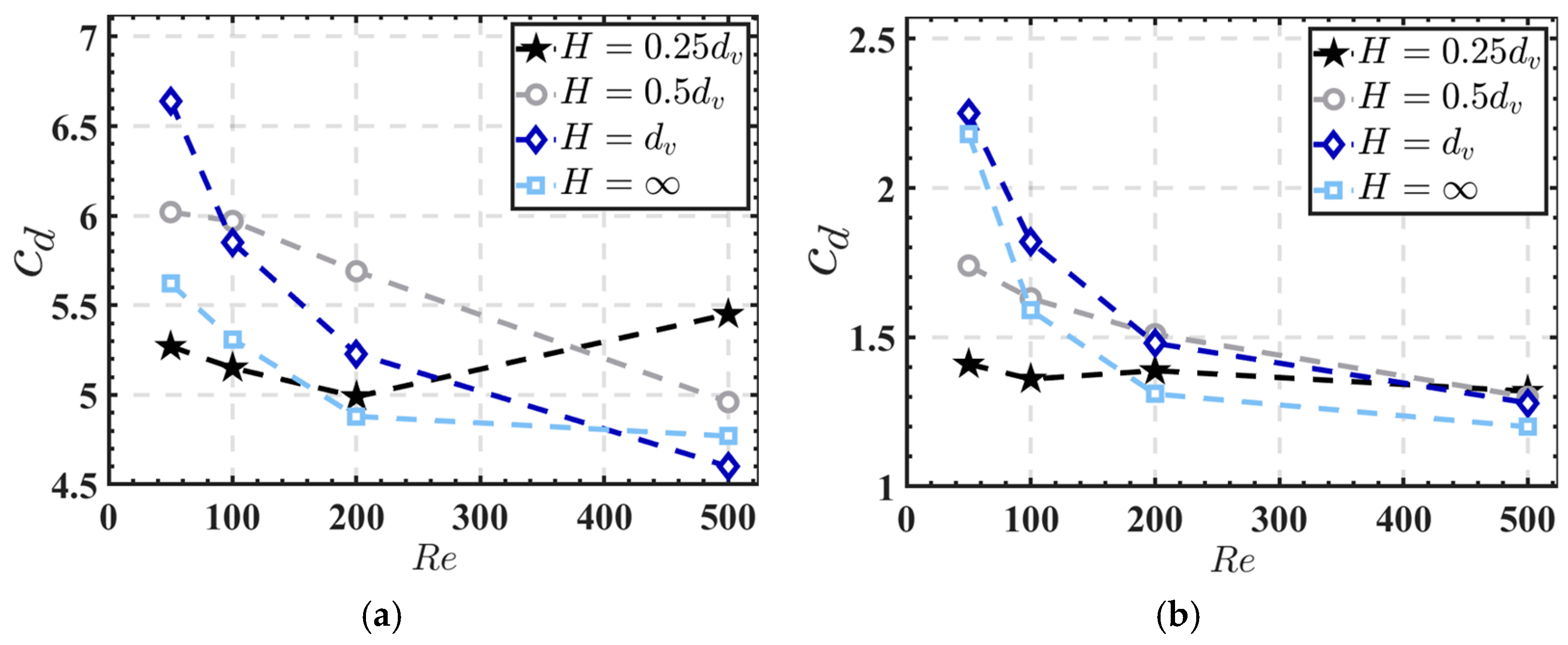
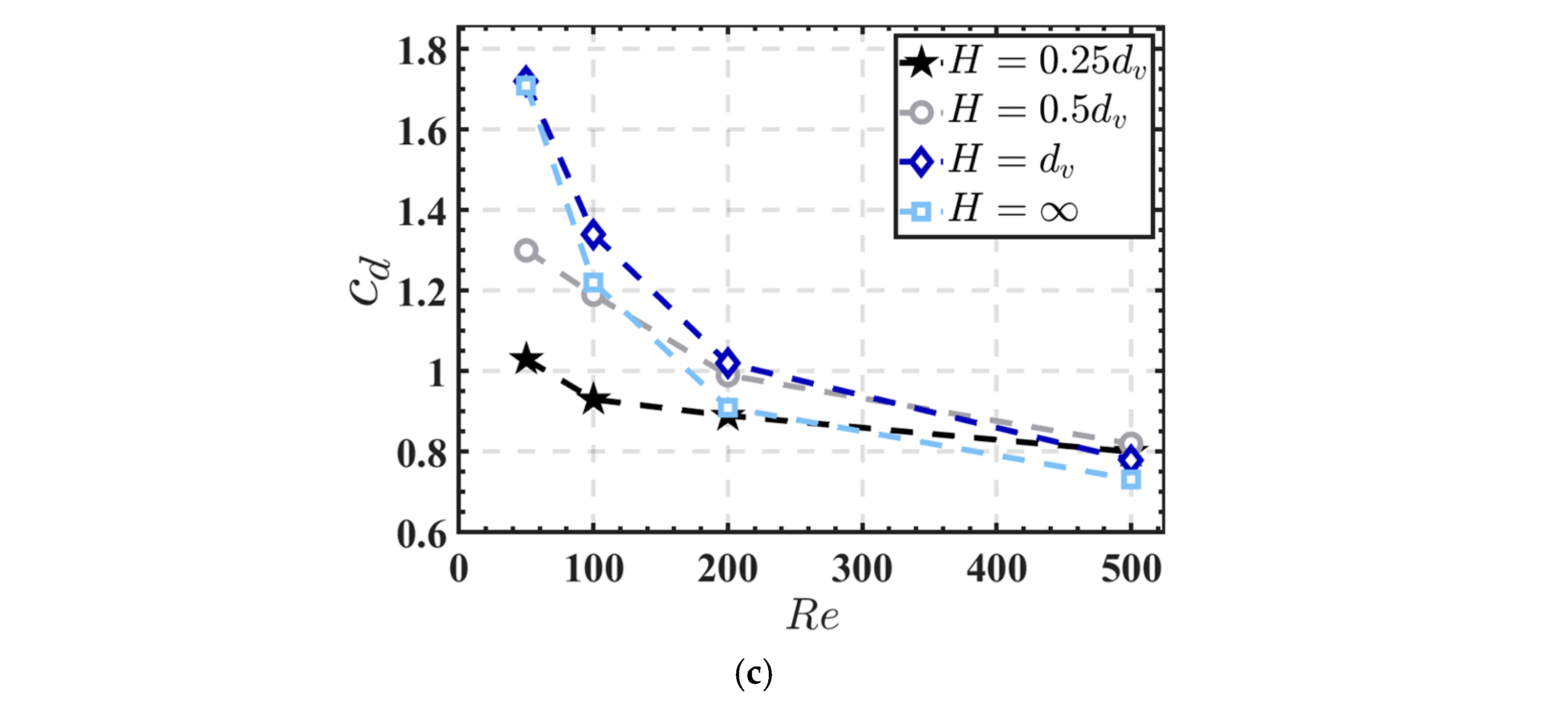




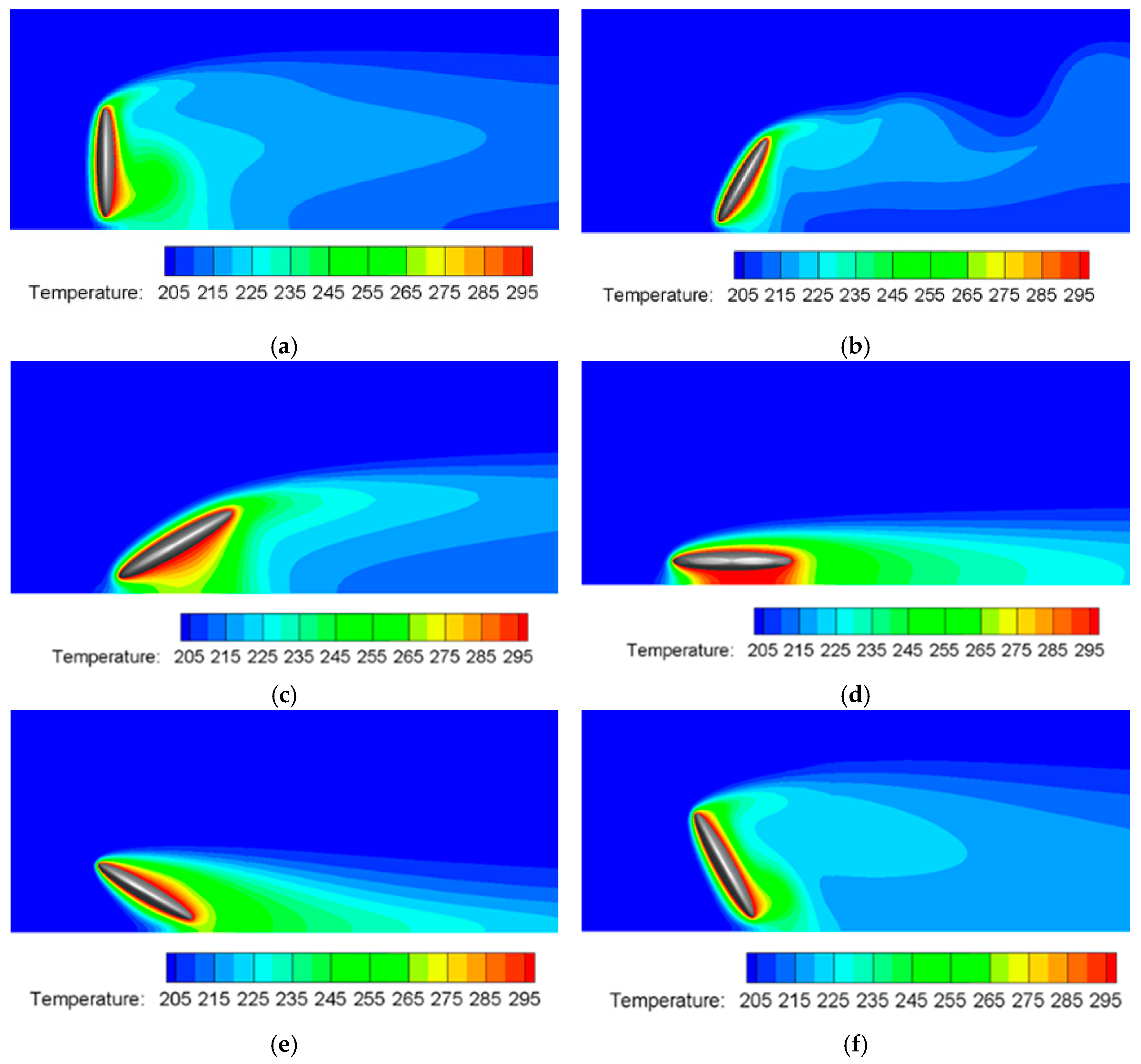
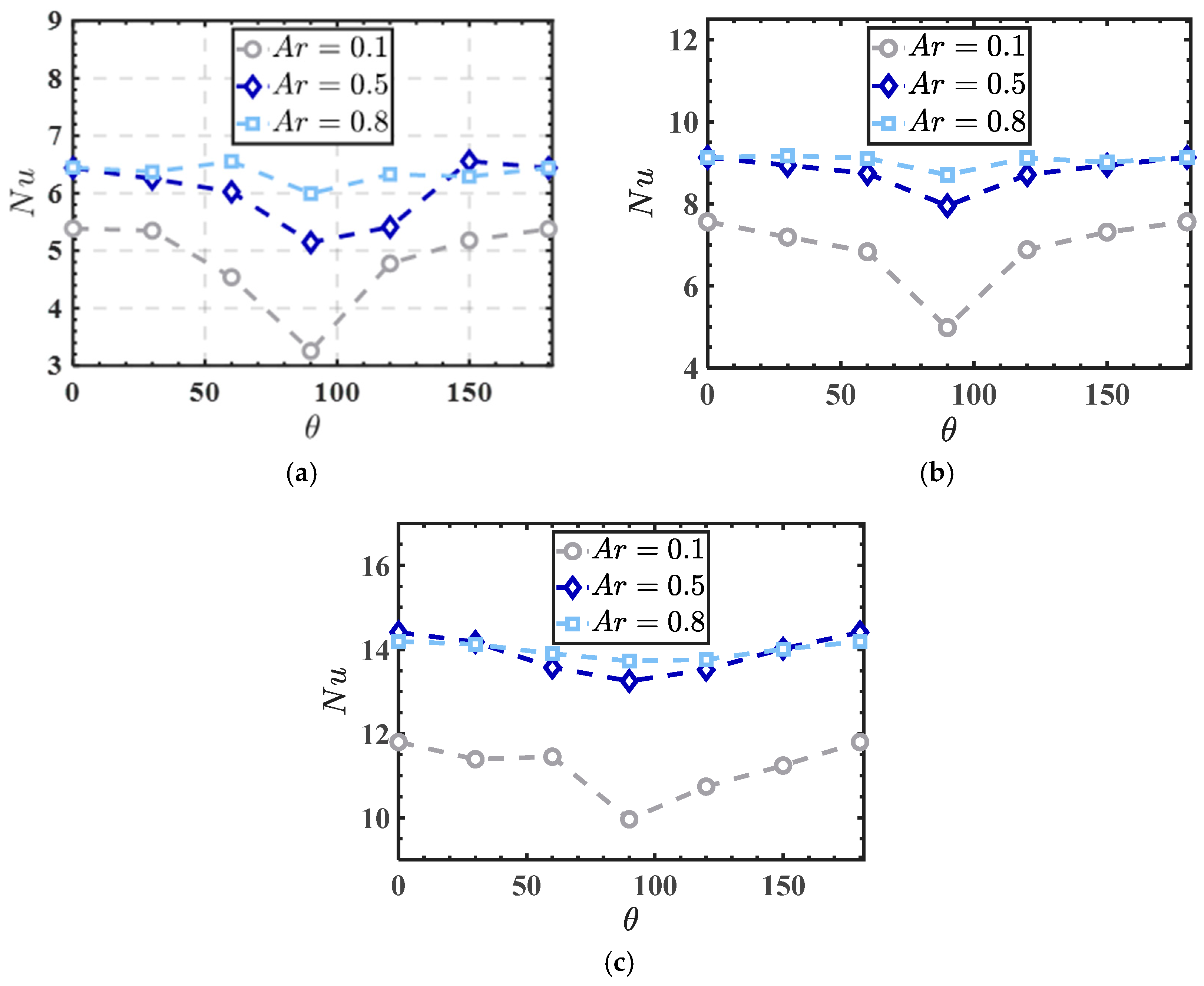
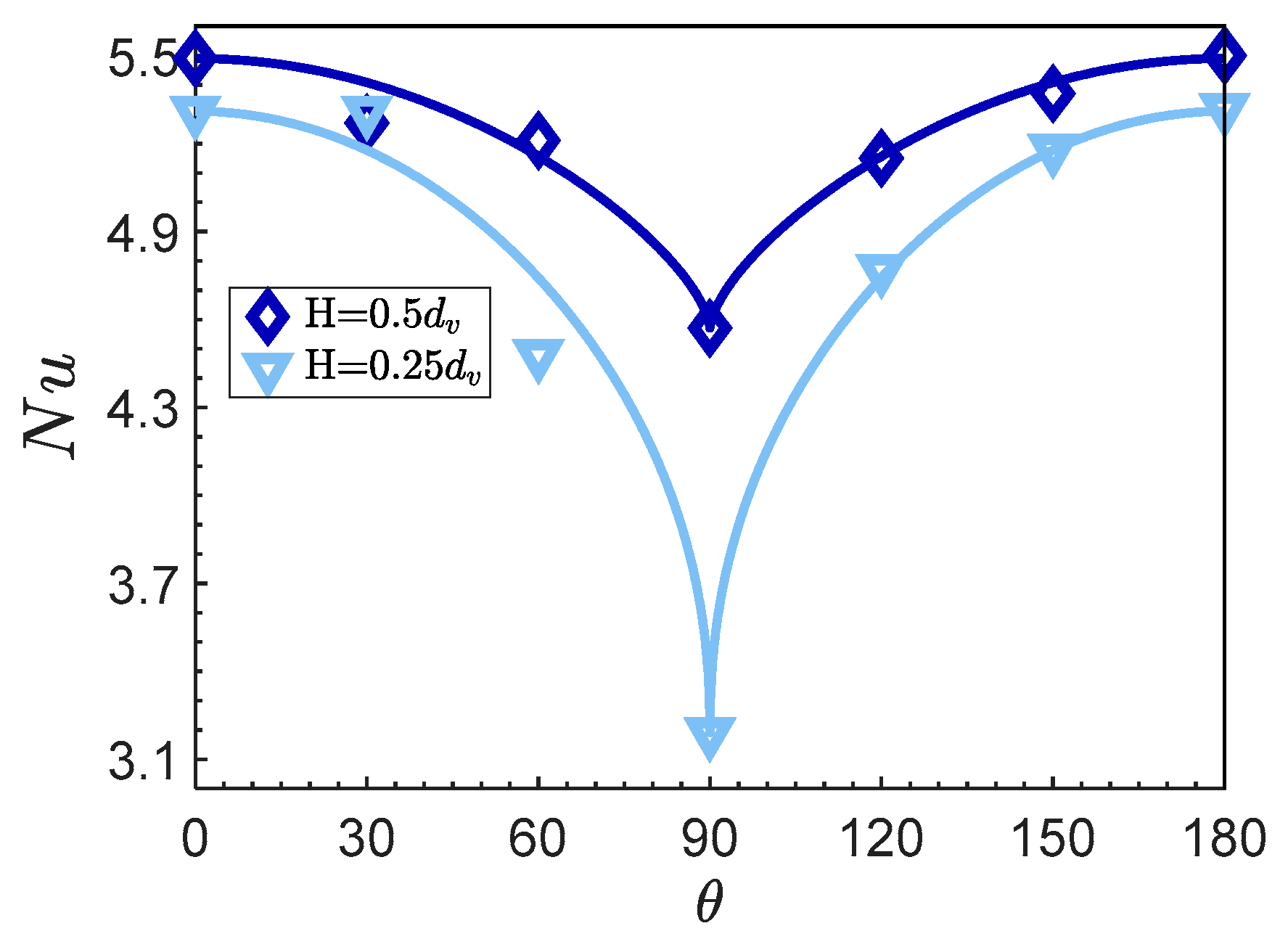

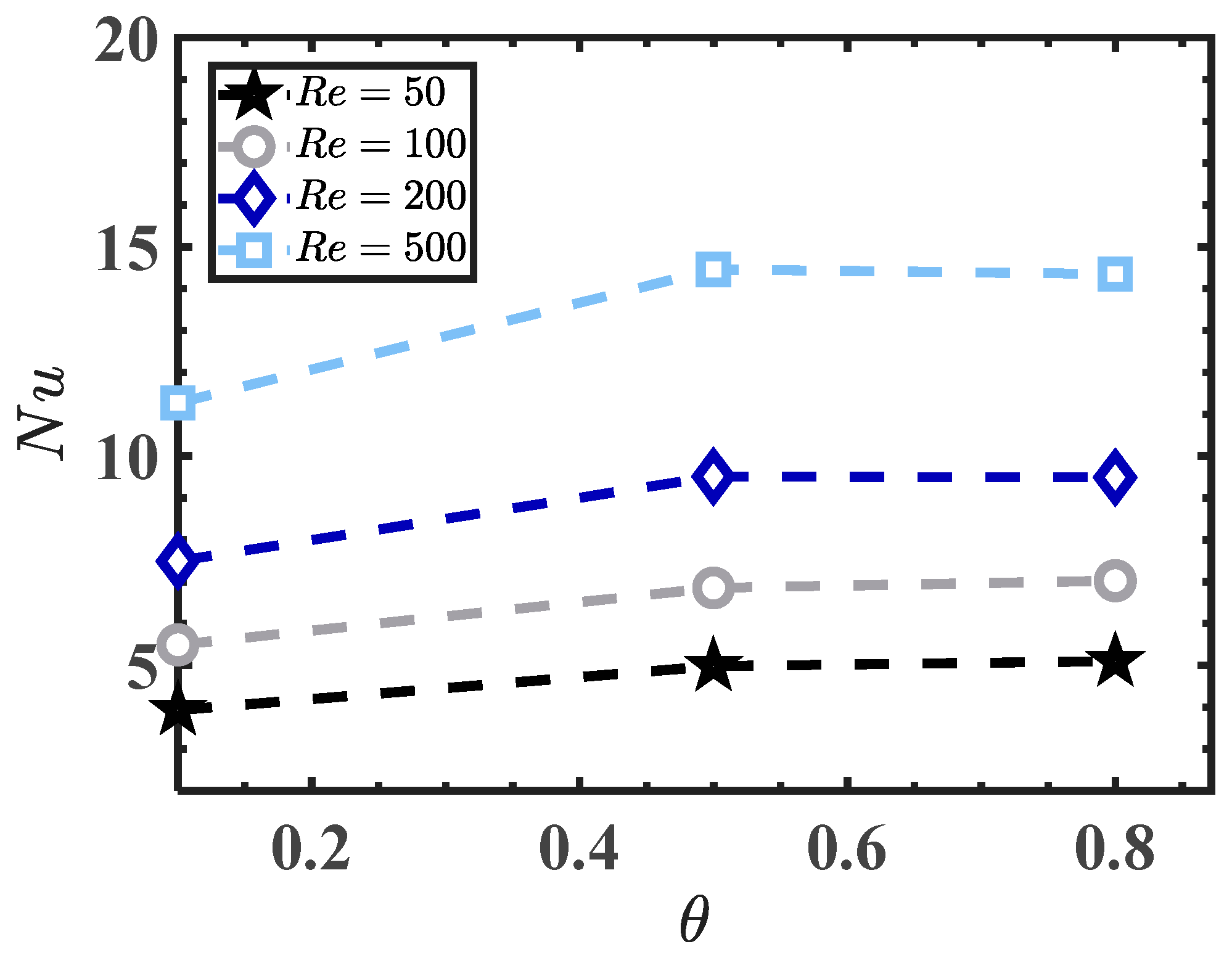
| Deviation (%) | |||
|---|---|---|---|
| 50 | 5.31 | 4.43 | 19.7 |
| 100 | 7.05 | 6.42 | 9.8 |
| 200 | 9.37 | 9.11 | 2.8 |
| 500 | 14.16 | 14.41 | −1.7 |
Disclaimer/Publisher’s Note: The statements, opinions and data contained in all publications are solely those of the individual author(s) and contributor(s) and not of MDPI and/or the editor(s). MDPI and/or the editor(s) disclaim responsibility for any injury to people or property resulting from any ideas, methods, instructions or products referred to in the content. |
© 2025 by the authors. Licensee MDPI, Basel, Switzerland. This article is an open access article distributed under the terms and conditions of the Creative Commons Attribution (CC BY) license (https://creativecommons.org/licenses/by/4.0/).
Share and Cite
Yang, Y.; Dong, X.; Xiong, T. Drag Force and Heat Transfer Characteristics of Ellipsoidal Particles near the Wall. Water 2025, 17, 736. https://doi.org/10.3390/w17050736
Yang Y, Dong X, Xiong T. Drag Force and Heat Transfer Characteristics of Ellipsoidal Particles near the Wall. Water. 2025; 17(5):736. https://doi.org/10.3390/w17050736
Chicago/Turabian StyleYang, Yongkang, Xinyu Dong, and Ting Xiong. 2025. "Drag Force and Heat Transfer Characteristics of Ellipsoidal Particles near the Wall" Water 17, no. 5: 736. https://doi.org/10.3390/w17050736
APA StyleYang, Y., Dong, X., & Xiong, T. (2025). Drag Force and Heat Transfer Characteristics of Ellipsoidal Particles near the Wall. Water, 17(5), 736. https://doi.org/10.3390/w17050736





